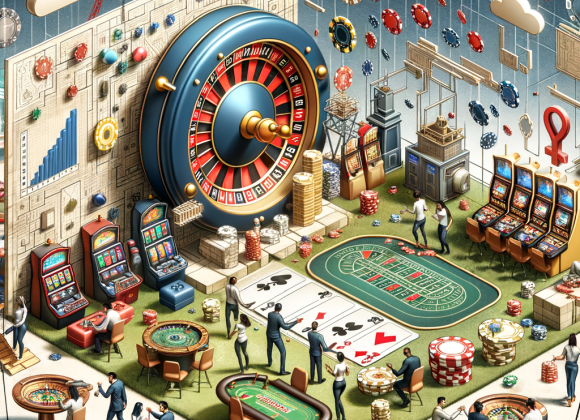Understanding the Basics of Casino Loyalty Programs
Casino loyalty programs, often referred to as player clubs, are designed to reward customers for their patronage. These programs operate on a points-based system where players earn points for every dollar spent on gaming, dining, and entertainment within the casino. Once these points accumulate, players can exchange them for various rewards, ranging from free play and dining credits to exclusive experiences and bonuses.
Most casinos offer tiered loyalty programs that categorize players into different levels based on their activity, such as Bronze, Silver, Gold, and Platinum. Higher tiers generally come with better perks, which incentivizes players to spend more to achieve elite status. The tier system is not just a marketing gimmick; it is rooted in the understanding that players are motivated by a desire to attain exclusive rewards.
Understanding the structure of these programs is crucial for players to maximize their benefits. Each casino has its own set of rules and rewards, so familiarizing oneself with the program specifics can lead to better strategies. Moreover, many casinos use digital platforms to track and manage loyalty points, making it easier for players to monitor their progress and redeem their rewards.
While loyalty programs are beneficial for casinos as they foster long-term relationships with players, they are also tailored to appeal to the emotional triggers of gambling. The idea of accumulating points and rising through tiers can create a sense of accomplishment and belonging among players.
In addition to traditional casinos, online platforms have adopted similar loyalty strategies, blending the convenience of digital gaming with the incentives of physical casinos. As technology continues to evolve, so too do the ways in which loyalty programs operate, making it essential for players to stay informed about their options.
In summary, casino loyalty programs are multifaceted structures designed to enhance customer engagement and retention by rewarding players for their loyalty. Understanding how these programs function is the first step toward making the most of them.
The Psychology Behind Customer Retention Strategies
The psychology underpinning casino loyalty programs employs various behavioral theories aimed at fostering long-term engagement. The “endowment effect,” for instance, suggests that once individuals start accumulating points, they perceive greater value in them, leading to a desire to maintain or enhance their status. This compels players to return to the casino to “protect” their investment in points and rewards.
Another vital element is the concept of “loss aversion,” which posits that people prefer to avoid losses over acquiring equivalent gains. In the context of loyalty programs, players may feel a heightened emotional response to losing their status or points than they would from gaining new ones. This psychological factor makes them more likely to return, even if it means spending more money.
Gamblers are also influenced by the “variable rewards” principle, where the unpredictability of rewards leads to higher levels of engagement. Casinos often create this effect through promotions or surprise bonuses that keep players on their toes, as they could potentially stumble upon an unexpected reward at any time.
The allure of achieving higher tiers within the loyalty program can also significantly impact player behavior. The social validation and prestige associated with being a top-tier member can lead to excessive gambling and spending, as players chase the next level of rewards. This phenomenon is often referred to as the “winner’s curse,” where the act of winning can lead to irrational decisions driven by the desire for more.
Moreover, casino loyalty programs often incorporate social elements, encouraging players to share their accomplishments and rewards with peers. This social validation not only strengthens loyalty to the casino but also attracts new customers who wish to experience the same perceived benefits.
By understanding these psychological tactics, casinos strategically design their loyalty programs to maximize player retention and spending, all while creating a community of engaged gamblers.
How Points and Tiers Drive Player Engagement
The structure of points and tiers in casino loyalty programs is a core mechanism that drives player engagement. Points are typically accumulated through various activities, including gaming, dining, and participating in promotions. The more a player spends, the more points they earn, which creates a direct incentive to engage with the casino continuously.
Tiers within these programs are designed to reward loyalty and incentivize players to reach higher levels. For instance, players in a tiered system may find that they need to accumulate a specific number of points within a given timeframe to maintain or elevate their status. This urgency can result in increased spending, as players push themselves to achieve their goals.
The appeal of tiered programs lies in the exclusivity they offer. Higher-tier members often receive additional perks such as personal hosts, access to exclusive events, and higher point multipliers. This creates a sense of prestige and accomplishment, motivating players to engage more actively with the casino.
Additionally, casinos frequently introduce limited-time promotions that allow players to earn bonus points. These promotions can be strategic, aligning with holidays or special events to capitalize on increased traffic. The sense of urgency and the potential for rapid point accumulation encourage players to visit the casino more often.
The gamification aspect of loyalty programs cannot be overlooked; the very act of tracking points and tiers adds a competitive element to the gambling experience. Players often compete against themselves or others to achieve a higher status, which can lead to increased engagement and loyalty.
In essence, the structure of points and tiers in casino loyalty programs is a powerful tool that not only drives player engagement but also encourages spending, making it a win-win for both casinos and players.
| Tier Level | Points Required | Rewards | Perks for Members |
|---|---|---|---|
| Bronze | 0-999 | Basic rewards, occasional promotions | Birthday bonuses, member-only promotions |
| Silver | 1,000-4,999 | Free play, discounted meals | Priority service, exclusive invites |
| Gold | 5,000-9,999 | Higher free play, hotel discounts | Personalized host, access to VIP events |
| Platinum | 10,000+ | Luxury rewards, premium experiences | 24/7 concierge, trip giveaways |
The Value Proposition: Are Rewards Worth the Spend?
Evaluating the value proposition of casino loyalty programs requires a careful cost-benefit analysis. At first glance, earning points and receiving rewards can seem attractive, but players must consider whether these benefits outweigh the money spent to acquire them.
For a player spending thousands of dollars at a casino, the rewards can be significant. Free plays and dining discounts can lead to substantial savings, making the loyalty program appealing. However, for casual players who do not spend as much, the benefits may be minimal compared to their expenditures.
Furthermore, casino loyalty programs often operate on a “break-even” point, where players must reach a threshold before truly benefiting. This can lead to a spending trap, where players feel compelled to gamble more to reach a level that offers meaningful rewards. As a result, the perceived value of rewards can be misleading.
To truly assess whether the rewards are worth the spend, players should calculate their effective return on investment (ROI). This involves taking into account the number of points earned, the benefits received, and the total amount spent at the casino. By doing so, players can determine if the program suits their gambling habits and financial situation.
It is also essential to consider the types of rewards offered. Some players may prioritize free play, while others may find dining experiences or hotel stays more valuable. Understanding personal preferences can help players make informed decisions about their engagement with loyalty programs.
In conclusion, while casino loyalty programs offer attractive rewards, players must critically evaluate their spending to determine if the benefits align with their gambling habits and financial goals.
Hidden Costs: The Fine Print of Loyalty Programs
While loyalty programs may appear beneficial, they often come with hidden costs that can erode perceived value. One common issue is the expiration of points. Many loyalty programs impose strict timelines for point usage, leading to player frustration when points become invalid due to inactivity or failure to meet spending thresholds.
Additionally, some loyalty programs have complex rules regarding tier progression and maintenance. Players may be required to spend a specific amount within a set timeframe to retain their tier status. If not met, players can find themselves demoted, losing access to the perks they have earned.
Moreover, the allure of rewards can sometimes lead to compulsive spending. Players may feel pressured to gamble more than they can afford in a bid to collect points, creating a cycle of financial strain rooted in the perceived need to maintain their loyalty status.
The fine print often also contains fees related to the program, such as maintenance fees or costs associated with redeeming rewards. These hidden costs can decrease the overall value players receive, making it essential to scrutinize the terms and conditions of loyalty programs before enrolling.
Transparency is often lacking in loyalty programs, and players may find it difficult to find clear information about how points are calculated or what rewards are truly attainable. This ambiguity can lead to disappointment and disillusionment as players navigate the complexities of the rewards system.
In summary, while casino loyalty programs can offer significant benefits, hidden costs and complex structures can diminish their value. Players must approach these programs with a critical eye, ensuring they fully understand the terms and conditions before engaging.
Maximizing Your Benefits: Tips for Savvy Gamblers
To truly capitalize on casino loyalty programs, players should adopt strategic approaches to maximize their benefits. One of the most effective ways to do this is by understanding the program’s specifics, including how points are earned, how long they last, and the timeline for tier progression.
Setting a budget is another crucial aspect of maximizing benefits. Players should establish a clear financial plan for how much they are willing to spend on gambling, ensuring that their participation in loyalty programs does not jeopardize their financial stability. This approach encourages responsible gambling while still benefiting from rewards.
Utilizing promotions and bonuses strategically can also enhance benefits. Many casinos offer special promotions that allow players to earn extra points or bonuses during specific events or holidays. Keeping an eye on these offers can significantly boost point accumulation without requiring additional spending.
Engaging with the casino’s staff can provide valuable insights. Players should not hesitate to ask questions about the loyalty program, inquire about upcoming promotions, or seek advice on how to maximize their points. Building a rapport with staff can lead to personalized offers that enhance the gaming experience.
Additionally, savvy gamblers should explore the option of combining loyalty programs across multiple casinos. Many casinos are part of larger networks that allow players to earn and redeem points across various locations. This strategy can widen the range of available rewards and provide more opportunities for point accumulation.
Lastly, regularly assessing your engagement with the loyalty program will help identify trends and areas for improvement. By tracking spending, points earned, and rewards redeemed, players can make informed decisions about their gambling habits and time spent at the casino.
In conclusion, maximizing benefits from casino loyalty programs requires strategic planning, responsible gambling, and proactive engagement. By implementing these tips, players can enjoy the rewards while minimizing the risks.
Q&A Section
Q: What should I look for in a casino loyalty program?
A: Look for clear terms and conditions, a transparent points accumulation system, valuable rewards, and a tier structure that aligns with your gambling habits.
Q: Can I lose my points or status in a loyalty program?
A: Yes, many loyalty programs have expiration dates for points and require players to maintain spending to keep their tier status.
Q: Are all casino loyalty programs the same?
A: No, each casino has its own loyalty program with different rules, rewards, and tier structures. It’s essential to read the specifics for each program.
Q: Is it worth spending more to reach a higher tier?
A: It depends. Assess the value of the rewards offered at higher tiers compared to your spending habits. If the benefits outweigh the costs, it may be worthwhile.
Q: How can I track my loyalty points?
A: Most casinos offer online accounts where players can monitor their points. Additionally, don’t hesitate to ask casino staff for assistance in tracking your progress.




